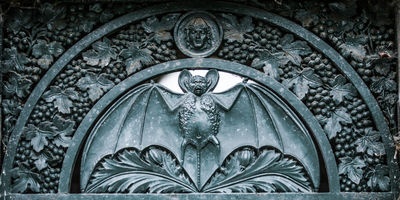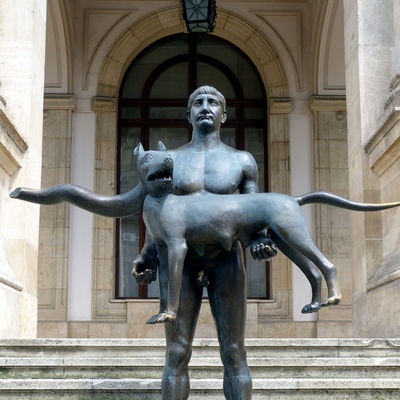|
 There are so many monuments in the world! In one of the English cemeteries ... a fish is buried. A rather curious inscription can be read on the tombstone: “Memory of the Old Fish. An old fish rests here. She lived for 20 years and then died. She was so tame - you know: she swam and took food from our hands. She died on April 20, 1885 at the age of 20 ”. There are so many monuments in the world! In one of the English cemeteries ... a fish is buried. A rather curious inscription can be read on the tombstone: “Memory of the Old Fish. An old fish rests here. She lived for 20 years and then died. She was so tame - you know: she swam and took food from our hands. She died on April 20, 1885 at the age of 20 ”.
The care and attention of the British, who buried the fish that are affectionate to people and perpetuated the memory of it, is touching. And yet it is difficult to suppress a smile as you read the inscription. The imagination draws sentimental old spouses, like Gogol's old-world landowners, a quiet pond with a mirror-green surface and a flock of good-natured lazy carps, amicably swimming to the sound and smell of food falling into the water. Nicely. Pleasantly. But in general, nothing special. In any case, the message of the magazine "Around the world" looks much more surprising:
“The Australian miller Luger was sitting on the bank of a mountain stream. Casting his fishing rod down, he gazed thoughtfully at the floating leaves. Suddenly the stream of water foamed, and in a second he saw in the stream a large beautiful trout... She floated upstream, towards the man. Fearing to move, Luger mechanically handed the worm, prepared for bait, to the trout. The motley fish boldly turned to the man, jumped out of the water and grabbed the worm ... Luger returned home without a catch: he fed the whole can of profit.
The next day, Luger met a "familiar" trout at the same place. So their friendship began ... "
Not only was the Captain (the miller gave such a nickname to his brisk acquaintance) was accustomed to understanding the intonation of a person's voice, swam to the call and swam away on command, allowed himself to be taken in hand - he gradually introduced Luger to a whole group of his friends — twenty trout!
In many countries there are special cemeteries for cats, dogs, and other pets. Naturally, the desire of those who have suffered a bitter loss of the affectionate Murka or the faithful Dzhulbars to honor the memory of their favorite. However, we are primarily interested in facts of a different kind, which have, so to speak, public significance.
Remains of an ancient bat monument have survived in Cuba in the village of Loma de Los Indios, in the Camaguey province. It was erected by the Indians long before the arrival of the Spanish conquerors on the island: they considered the bat to be a sacred animal. "Monument" is an earthen hill three meters high and more than 100 meters long, the shape of which copies the shape of a bat in flight.
 Of course, the memorial stone erected by the inhabitants of the village of Wick in Westmoreland (England) should be classified among the curious monuments. Every year, on a certain day, fellow villagers gather at this stone for a meeting. From the speeches delivered at the rally, it is easy to understand that both the stone and the meeting are dedicated to the commemoration of the event of 1841, when hordes of wasps attacked the village ... Immediately after the official part of the festival, the inhabitants of Wick, according to tradition, go in search of the nests of those same malignant insects, from which their ancestors once suffered. On this day, the wasps are not given mercy. Of course, the memorial stone erected by the inhabitants of the village of Wick in Westmoreland (England) should be classified among the curious monuments. Every year, on a certain day, fellow villagers gather at this stone for a meeting. From the speeches delivered at the rally, it is easy to understand that both the stone and the meeting are dedicated to the commemoration of the event of 1841, when hordes of wasps attacked the village ... Immediately after the official part of the festival, the inhabitants of Wick, according to tradition, go in search of the nests of those same malignant insects, from which their ancestors once suffered. On this day, the wasps are not given mercy.
Agricultural pests destroy gardens and crops. It is clear that they deserve nothing else but dislike and persecution from the farmer. Nevertheless, a monument was erected to one of such pests - the cotton weevil - in the city of Enterprise (USA, Alabama) in gratitude for the extermination of nine-tenths of the cotton crop in 1915! Is it strange? Unnatural? Let's not rush to conclusions.
For a long time, Alabama farmers sowed exclusively cotton, and growing it was a profitable business.The stubborn farmers did not react to the repeated warnings of specialists about the dangers of monoculture. The end of the self-confidence of the Alabamians was laid by the devastating invasion of the crops of the cotton weevil. Having suffered huge losses, the farmers finally started growing groundnuts, corn, potatoes, and with joyful surprise found that in just a year they were able to improve their badly shaken business. In gratitude "for science" the monument mentioned above was erected, the inscription on which reads: "With deep gratitude to the cotton weevil for the fact that it served as a cause of prosperity, this monument was erected by the inhabitants of the city of Enterprise."
And here is another curious case. On July 6, 1958, in the Japanese city of Osaka, a white marble statue was erected in a solemn atmosphere on the symbolic grave of dogs left in Antarctica for certain death. A year later, it turned out that the monument was in vivo.
It happened like this. The Japanese Antarctic expedition in February 1958, due to severe ice and meteorological conditions, was unable to land the wintering group. The Seva station was temporarily closed and its personnel removed. During the evacuation of the station, Japanese researchers were forced to leave several huskies in Antarctica. The dogs were tethered and left with food for 3-4 weeks. Needless to say, the members of the expedition said goodbye to the dogs on their way back from the inhospitable shores of the sixth continent. That is why a white marble statue appeared in Osaka. Great was the surprise of the polar explorers who returned to the station a year later when two dogs greeted them with joyful barking! The huskies managed to break the leash and all this time they were apparently feeding on penguins and their eggs ...
Every schoolchild knows that monkeys are inhabitants of mainly countries with hot climates. In Europe, in any case, they are not found, except for a small colony of macaques, once brought to Gibraltar. Nevertheless, it was on the European continent that he erected probably the only monument on earth.
In Germany, near Kassel, a monument erected on the grave of the monkeys has survived to this day. Since 1763, for a full twenty years, African immigrants surprisingly well felt on German soil. The macaques accompanied their owner Count Schlieffen to the borders of the estate when he left for the city. But then one of the monkeys was bitten by a mad dog, and the old count reluctantly was forced to give the order to shoot the whole flock, and put a monument on the grave.
 The largest animal of the Ice Age, the mammoth stopped roaming the earth a long time ago, and a monument was erected to him in the last century. It is located on the territory of our country. The largest animal of the Ice Age, the mammoth stopped roaming the earth a long time ago, and a monument was erected to him in the last century. It is located on the territory of our country.
In 1839, not far from the Ukrainian village of Kuleshovka (now the Nedrigailovsky district of the Sumy region), local residents engaged in excavation work discovered the skeleton of a mammoth. Professor of Kharkov University I. I. Kalinichenko organized excavations, and in 1841, at his insistence, a three-meter-high cast-iron monument was erected here, on which the skeleton of a fossil giant is depicted and inscriptions are placed. One of the inscriptions reads: "At this place in 1839 the skeleton of the pre-Flood mammoth was discovered." ("Pre-Flood" because, in accordance with religious dogmas, all animals that have not survived to this day died allegedly during a global flood.)
And if there was no specific reason, a monument to the mammoth should have been erected - the hairy elephant deserved it. In the life of primitive people, he played almost the title role: they ate mammoth meat, the skin was used for clothing, and dwellings were built from bones. At one of the sites of the Stone Age, bones of 800-1000 giants were found!
But, looking at the cast-iron monument to the mammoth, one also feels a feeling of regret that scientists have to study the life and habits of this most interesting animal only from fossil remains.Mammoths, researchers argue, could exist today. They did not die as a result of a sudden change in climate or from any other natural disasters; shaggy giants who lived in the 1st millennium AD were exterminated by people.
However, the saddest monuments are those of the wolf. The small town of France, Morestel, received unusual fame as a result of the fact that the last wolf in the country was killed in its vicinity. Two thousand beaters, sixty gendarmes, a thousand hunters, three airplanes, the latest equipment for constant communication - all these solid human and material resources were mobilized for a raid on a single animal. When the "hunt" was crowned with triumph, a furious dispute over the skin broke out. Hunters from three villages - Sermerie, Vaslen and Vigny - had to draw up an official agreement on this score: “... moved by the spirit of brotherly solidarity and the desire to provide a rare hunting trophy for posterity ... we agreed that the wolf should become the indivisible property of the inhabitants Vigny, Sermerie and Vaslen. Morestel must keep it and take care of its safety, in connection with which he will pay insurance premiums for it in the amount of 200,000 francs ... "
The municipality, for its part, issued a decree on the annual celebration of the "day of the last wolf of France." On this day, it was thought to arrange folk festivals and fireworks. And all this (just like a stuffed wolf) was supposed to serve as a bait for tourists.
Unusual monuments is available in any country. In England, near the city of Carmanten, - on the place where, according to official statistics, the last wolf in the country was shot in 1880 - there is a monument dedicated to this event. And this is more bitter than touching.
Scientists from many countries, relying on weighty arguments, advocate today for the prohibition of the thoughtless and indiscriminate extermination of an intelligent and powerful beast, which is undoubtedly of great interest for science and practice. Recently, the tragic fate of the wolf worries people of many specialties. Fiction writers are no exception. Here is what is said, for example, in the story of G. Troepolsky "White Bim Black Ear":
 “The last wolves walk ... They walk in order to destroy scabies foxes, protecting others from infection, they walk in order to destroy them in huge numbers during the breeding years of mice carrying tularemia. The last wolves on earth are walking. " “The last wolves walk ... They walk in order to destroy scabies foxes, protecting others from infection, they walk in order to destroy them in huge numbers during the breeding years of mice carrying tularemia. The last wolves on earth are walking. "
And further:
“... And you know, man, that a she-wolf will not touch a little puppy - a sucker of a dog, but will accept him as a child; and will not touch a small child, but will drag it into the den and push it to the nipples. How many of them, such cases, when a wolf from a man-child fed a man-wolf! Jackals cannot do that. Even dogs can't. Will a wolf touch a sheep in its home area, where it lives? Never. But you're still afraid of the wolf, man. So hatred, overshadowing the mind (unlike animals), can sometimes take over a creature so that the useful is considered harmful, and the harmful - useful. "
Misunderstandings about the harm and benefits of this or that animal sometimes cost people dearly. Let us recall the history of the extermination of sparrows in China. During 1957-1958, more than one and a half billion "harmful" birds were destroyed there. And immediately the Chinese were severely punished for their indiscretion: the gardens were attacked by pests - insects, and there was no one to destroy them. Indeed, only one pair of sparrows catches up to five hundred insects per day during the feeding period, four hundred of which are harmful. Unwisely taking up arms against "their" sparrows, the Chinese were later forced ... to import these birds from neighboring Mongolia.
A similar story, but only with leopards, happened in the African state of Sierra Leone. The old-timers have not yet forgotten those times when the forests surrounding the capital - the city of Freetown - were teeming with leopards. War was declared on the spotted cats and almost all were destroyed.And then monkeys bred in unimaginable numbers, for which there is no more dangerous animal than a leopard. The monkeys became insolent to such an extent that they appeared on the central streets of the capital, they devastated all the gardens and vegetable gardens of the Freetauans. And the city authorities had to take urgent measures: to buy several pairs of leopards and release them into the surrounding forests.
The situation is approximately the same with the destruction of wolves. No wonder the scientists of the Max Planck Institute recently made an attempt to acclimatize several schools of predators in the forests of Bavaria, where they disappeared a hundred and fifty years ago. Professor of zoology at the University of Birmingham B. Gap came up with a proposal to introduce a wolf in the highlands of Scotland; the scientist is convinced that this will improve the condition of the roe deer herd. The fight against wolves has been stopped for twenty years in most national parks in the United States and Canada. Polish hunting experts think about the prohibition of indiscriminate extermination of the gray predator.
Krasnopevtsev V.P. - Seagulls on a pedestal
|
 There are so many monuments in the world! In one of the English cemeteries ... a fish is buried. A rather curious inscription can be read on the tombstone: “Memory of the Old Fish. An old fish rests here. She lived for 20 years and then died. She was so tame - you know: she swam and took food from our hands. She died on April 20, 1885 at the age of 20 ”.
There are so many monuments in the world! In one of the English cemeteries ... a fish is buried. A rather curious inscription can be read on the tombstone: “Memory of the Old Fish. An old fish rests here. She lived for 20 years and then died. She was so tame - you know: she swam and took food from our hands. She died on April 20, 1885 at the age of 20 ”. Of course, the memorial stone erected by the inhabitants of the village of Wick in Westmoreland (England) should be classified among the curious monuments. Every year, on a certain day, fellow villagers gather at this stone for a meeting. From the speeches delivered at the rally, it is easy to understand that both the stone and the meeting are dedicated to the commemoration of the event of 1841, when hordes of wasps attacked the village ... Immediately after the official part of the festival, the inhabitants of Wick, according to tradition, go in search of the nests of those same malignant insects, from which their ancestors once suffered. On this day, the wasps are not given mercy.
Of course, the memorial stone erected by the inhabitants of the village of Wick in Westmoreland (England) should be classified among the curious monuments. Every year, on a certain day, fellow villagers gather at this stone for a meeting. From the speeches delivered at the rally, it is easy to understand that both the stone and the meeting are dedicated to the commemoration of the event of 1841, when hordes of wasps attacked the village ... Immediately after the official part of the festival, the inhabitants of Wick, according to tradition, go in search of the nests of those same malignant insects, from which their ancestors once suffered. On this day, the wasps are not given mercy. The largest animal of the Ice Age, the mammoth stopped roaming the earth a long time ago, and a monument was erected to him in the last century. It is located on the territory of our country.
The largest animal of the Ice Age, the mammoth stopped roaming the earth a long time ago, and a monument was erected to him in the last century. It is located on the territory of our country. “The last wolves walk ... They walk in order to destroy scabies foxes, protecting others from infection, they walk in order to destroy them in huge numbers during the breeding years of mice carrying tularemia. The last wolves on earth are walking. "
“The last wolves walk ... They walk in order to destroy scabies foxes, protecting others from infection, they walk in order to destroy them in huge numbers during the breeding years of mice carrying tularemia. The last wolves on earth are walking. "









